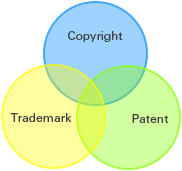- -Able to understand what copyright is and how it is applied.
-
Copyright
Click on the Play button to start the introduction video.
-
Show Me!
Show Me!
What is Copyright?Click on the Play button to start the video.
Copyright:
- allows people such as authors and musicians to make money from what they have created.
- prevents others from taking their work for free or changing it in any way without permission.
Copyright protects such things as:
- literary works.
- musical works.
- dramatic works.
- pictorial, graphic and sculptural works.
- movies, videos, DVD's.
- sound recordings.
- architectural works.
Copyright gives the creator the right to do any of the following or to let others do any of the following:
- make copies of the work.
- distribute copies of the work.
- perform the work publicly.
- display the work publicly.
- make modifications, adaptations or translations.
In general, it is illegal for anyone to do any of the above without the permission of the author.
Show Me!
Copyright and Intellectual PropertyClick on the Play button to start the video.
Intellectual Property is anything that is created through work of the mind or intellect, such as:
- an idea.
- an invention.
- a program.
- data.
- a formula.
Intellectual property can be divided into three sections:
- copyrights.
- trademarks.
- patents.
Copyright protects the author's original ideas or work that is in a physical form, such as:
- a book.
- a piece of recorded music.
- a computer program.
- a screenplay.
- a painting.
- a photograph.
- a movie.
Trademark protects:
- brand names.
- symbols.
- other devices identifying a product.
Patent protects the making, selling or use of an invention or process.
Show Me!
The relationship between copyright and plagiarism can be tricky to understand. Copyright is a federal law whereas plagiarism is a type of misconduct.
Plagiarism is:
- using someone else's words and ideas and acting as though they are your own.
- stealing the ideas of another person without giving the creator proper credit.
This includes:
- copying someone else's ideas, graphs or pictures, without giving credit to the creator.
- anything you download from an Internet site or copy out of a book, newspaper, magazine or brochure.
-
Say It
There are 2 parts in this section.
1. The GlossaryThe glossary lists the more difficult words related to the topic in alphabetical order. The glossary also gives the meaning for each word.
2. Look, Cover, Write, Check!This activity gives you practice at remembering and writing the words from the glossary.
The Glossary
-
Do It
Copyright gives the absolute rights to the original creator of any work. A copyright is your right to your copy. You have the right to make copies, to sell your work, to share it, to reproduce it and so on. No one else has this right until you sign it over, or give some form of consent or permission.
Copyright gives the ability for companies and for individuals to prevent the complete copying of books, music, photographs or any sort of created materials from being recreated and resold by someone else. It is important to note that online text, images, broadcasts, videos and music on websites, wikis, blogs and social networking sites are all protected by copyright.
It is illegal to reprint or redistribute copyrighted material, and in a case where a person has done this, that person can be in a lot of trouble.
Jump to ActivitiesDo It: What is Copyright and How Does it Work?
Copyright allows authors, musicians, artists, etc to make money from what they have created. It prevents others from taking the work for free or changing it in any way without permission.
Copyright gives the author the right to do any of the following or to let others do any of the following:
- make copies of the work;
- distribute copies of the work;
- perform the work publicly (such as for plays, film, dances or music);
- make modifications, adaptations or translating the work from one form to another; and
- display the work publicly (such as for artwork, stills from audio-visual works, or used on the Internet or television).In general, it is illegal for anyone to do any of the things listed above without the permission of the author.
Do It: Copyright and Intellectual Property
Intellectual Property is property that is developed through work of the mind or intellect. Some examples are an idea, invention, program, data, formula, patent, copyright, or trademark.

Intellectual property can be divided into three sections: copyrights, trademarks and patents.
As you have learnt earlier, copyright protects the author's original ideas or work that is in a physical form, such as a book, piece of recorded music, computer program, screenplay, painting, photograph, or a movie.
Trademark protects brand names, symbols, or other devices identifying a product.
Patent protects the making, selling or use of an invention or process.
Do It: Plagiarism
Plagiarism is using someone else's words and ideas and acting as though they are your own. It is stealing the ideas of another person without getting permission.
It includes images, written material, and ideas that you download from an Internet site or copy out of a book, a newspaper, a magazine or a brochure.
For example, in the tourism industry it is important that you do not copy information or pictures from brochures and reuse it in your own documents. In the hospitality industry, recipes cannot be taken out of cookbooks or from the Internet and copied as though you created them yourself.
Check It
Check It QuizCopyrightClick on Copyright to begin.
- Introduction
- Show Me
- Say It
- Do It
- Check It





